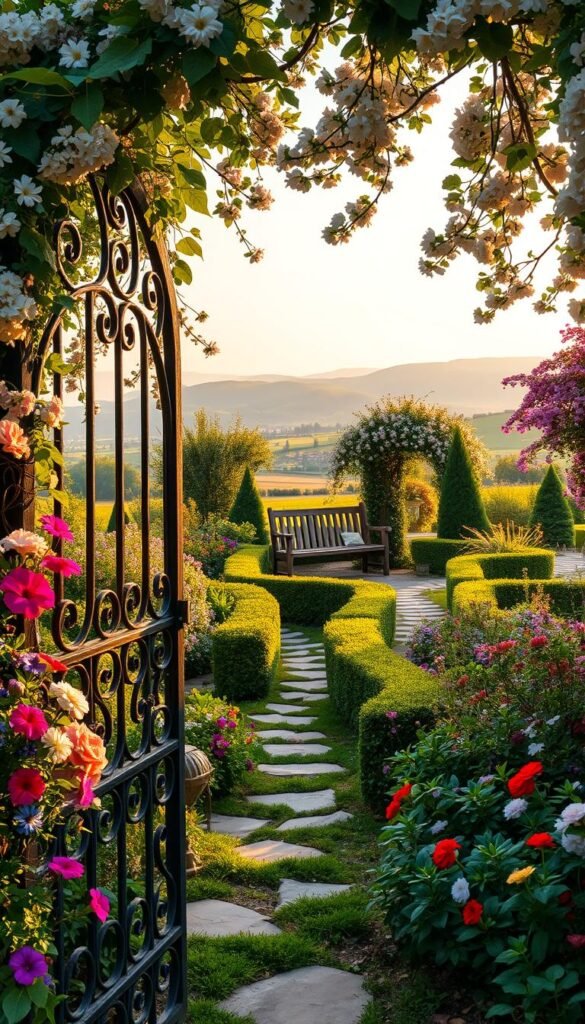Imagine stepping into a vibrant oasis where flowers spill over pathways and herbs mingle with roses. This whimsical style traces back centuries to English countrysides, where families grew edible crops alongside blooms for both sustenance and beauty. What began as practical plots evolved into romantic escapes bursting with color and texture.
Today’s versions blend nostalgia with modern needs. They thrive in tight urban yards or sprawling suburban areas, offering layered plantings that feel abundant yet intimate. You’ll find climbing vines framing entryways and fragrant lavender bordering stone paths – a balance of wildness and intention.
These spaces excel at elevating your space through strategic design. Dense arrangements hide boundaries, while mixing perennials with seasonal annuals ensures year-round interest. Even fruit trees or vegetable patches can weave into the scenery, maintaining that carefree lived-in allure.
In the following sections, we’ll share creative ways to craft your own retreat. Discover how to maximize vertical growth, choose pollinator-friendly varieties, and incorporate rustic accents. Whether you’re transforming a balcony or redesigning a backyard, these principles adapt effortlessly to any size.
Embracing the Cottage Garden Aesthetic
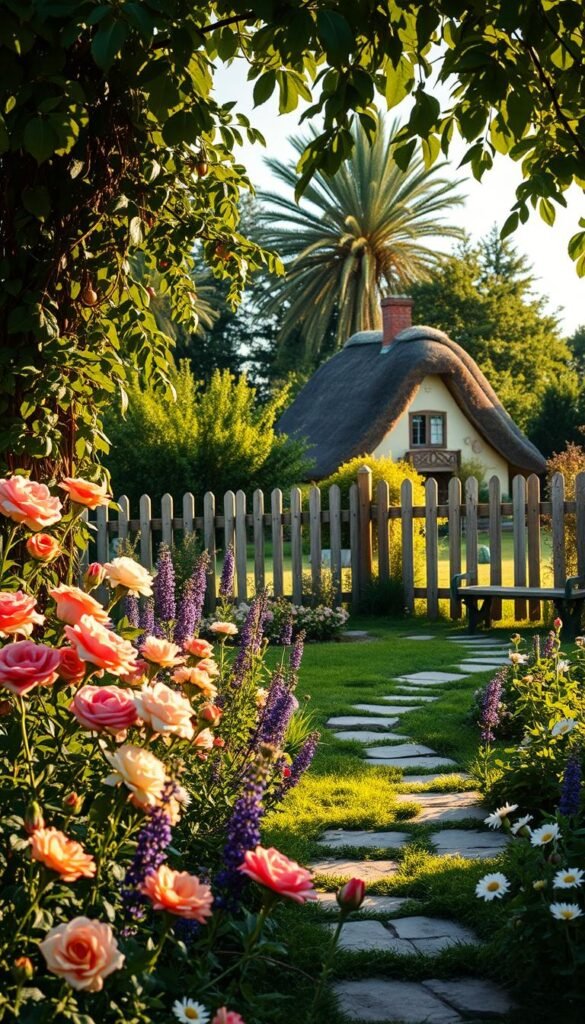
The cottage garden aesthetic celebrates nature’s untamed beauty while weaving in thoughtful design. Unlike formal landscapes, these spaces thrive on spontaneity—think blooms spilling onto walkways and fragrant herbs brushing against your ankles as you wander. There’s freedom in this approach: no strict symmetry or perfect rows, just layers of color and texture that feel effortlessly alive.
Understanding the Charm of Cottage Gardens
At the heart of this style lies a relaxed philosophy that prioritizes abundance over precision. Tall hollyhocks might tower behind clusters of daisies, while creeping thyme softens stone edges. Fragrance plays a starring role, with lavender and roses releasing their scents as you pass by—a sensory nod to traditional English gardens.
Visual depth comes from mixing heights and forms. Delicate cosmos dance beside spiky foxgloves, creating dynamic contrasts. Self-seeding plants like poppies add surprises each season, ensuring your space evolves naturally over time.
Creating a Welcoming Outdoor Oasis
To balance wildness with structure, incorporate elements like weathered arbors or low stone walls. These features guide growth without stifling it, offering support for climbing roses or clematis. Cozy nooks with benches tucked among plantings invite you to pause and enjoy the view.
Embrace imperfections—a few unruly stems or fading blooms add character. This style isn’t about maintenance but creating a living tapestry that shifts with the seasons, always offering something new to discover.
10 Small Cottage Garden Ideas for a Quaint and Charming Look
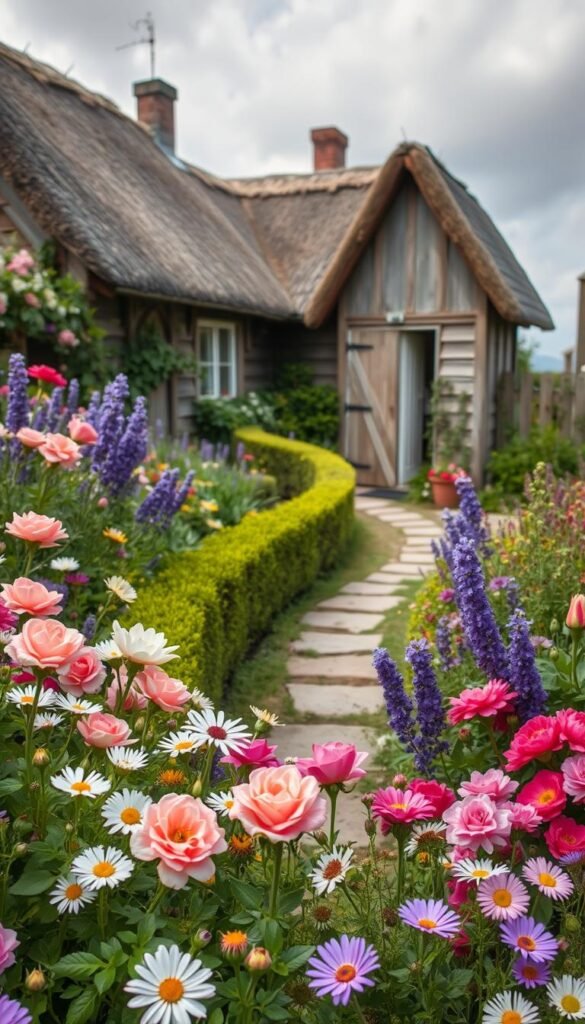
Transform your outdoor area into a lush retreat with clever strategies that blend tradition and innovation. Whether you’re working with a balcony or a backyard, these concepts prioritize visual impact without sacrificing practicality.
Start by layering vertical elements like trellises or obelisks. They add height and support climbing roses or sweet peas, making tight spaces feel grander. Pair them with colorful container flowers for movable bursts of charm.
Here’s how to maximize your plot:
- Mix perennials like lavender with seasonal annuals for nonstop blooms
- Use curved pathways edged with thyme to create flow
- Incorporate repurposed materials – think vintage troughs as planters
Strategic plant placement tricks the eye into seeing abundance. Place taller varieties at the back and let spillers like nasturtiums cascade over edges. For year-round interest, blend evergreen shrubs with flowering cottage classics like peonies.
Modern twists include drought-resistant options and self-watering systems from expert tips. These updates reduce upkeep while preserving that wild, romantic vibe. Even tiny corners can thrive when every inch serves multiple purposes – a bench surrounded by herbs becomes both seating and a sensory experience.
Designing Inviting Seating Areas and Garden Benches
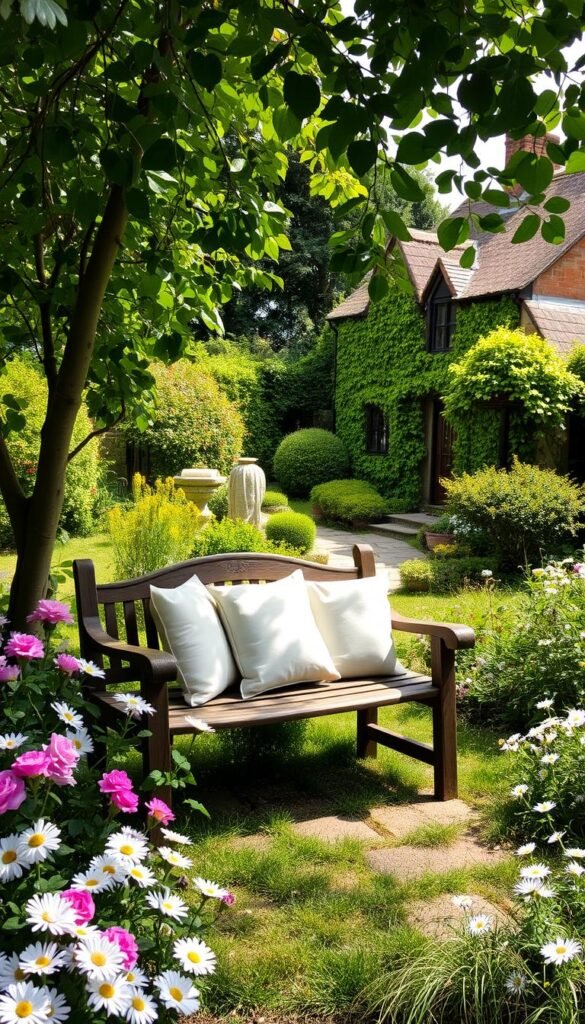
A well-placed bench transforms your garden into a retreat where you can savor morning coffee or watch fireflies at dusk. Start by selecting materials that age gracefully—weathered cedar blends with rustic charm, while wrought iron develops a soft patina over time.
Choosing the Right Bench for Relaxation
Opt for curved designs that mirror organic shapes in your cottage landscape. Position benches where they frame views of blooming clusters or catch afternoon shade. For strategic seating arrangements, consider these elements:
- Teak or recycled plastic for durability
- Armrests that double as plant ledges
- Open-back styles allowing vines to weave through
Integrating Seating with Natural Elements
Surround benches with sensory plants—jasmine for evening fragrance or lamb’s ear for tactile leaves. Built-in stone seats edged with creeping thyme create seamless transitions between hardscape and blooms. Add weather-resistant cushions in floral patterns to echo nearby petunias or daisies.
For intimate dining areas, tuck a bistro set beneath an arbor dripping with wisteria. The dappled light and floral scent turn simple meals into immersive experiences. Even a tree stump topped with a circular slab becomes a whimsical perch when surrounded by lavender.
Incorporating Vertical Elements with Arbors and Pergolas
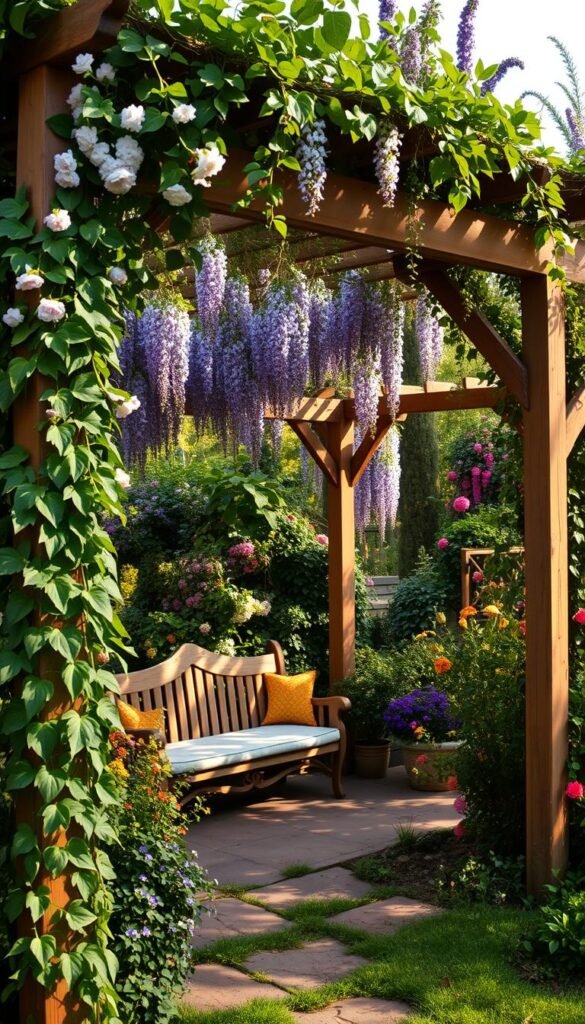
Elevate your landscape by introducing vertical structures that draw the eye upward and multiply planting opportunities. Arbors and pergolas add height and structure while serving as living frames for climbing plants. These elements transform flat spaces into layered retreats where blooms cascade overhead and pathways feel enveloped in greenery.
Enhancing Height With Climbing Plants
Choose fast-growing vines like clematis or climbing roses to dress arbors quickly. These climbing plants soften wooden beams while providing seasonal color – think spring wisteria blooms or autumn ivy turning crimson. Pair them with fragrant jasmine or honeysuckle for evening scent near seating areas.
| Plant | Bloom Season | Support Type |
|---|---|---|
| Clematis | Spring-Fall | Arbors |
| Climbing Roses | Summer | Pergolas |
| Sweet Peas | Spring | Trellises |
| Ivy | Year-round | Stone Walls |
Using Pergolas to Define Space
Position pergolas to create distinct zones – a dining area under flowering vines or a shaded reading nook. These structures offer stability for heavy climbers like climbing hydrangea while sheltering benches below. Add string lights between beams for magical evening ambiance.
For low-maintenance options, use weather-resistant cedar or powder-coated metal frames. Train annuals like morning glories on removable trellises for easy seasonal updates. Underneath, plant foxgloves or hostas to complement overhead blooms.
Laying Natural Paths and Walkways
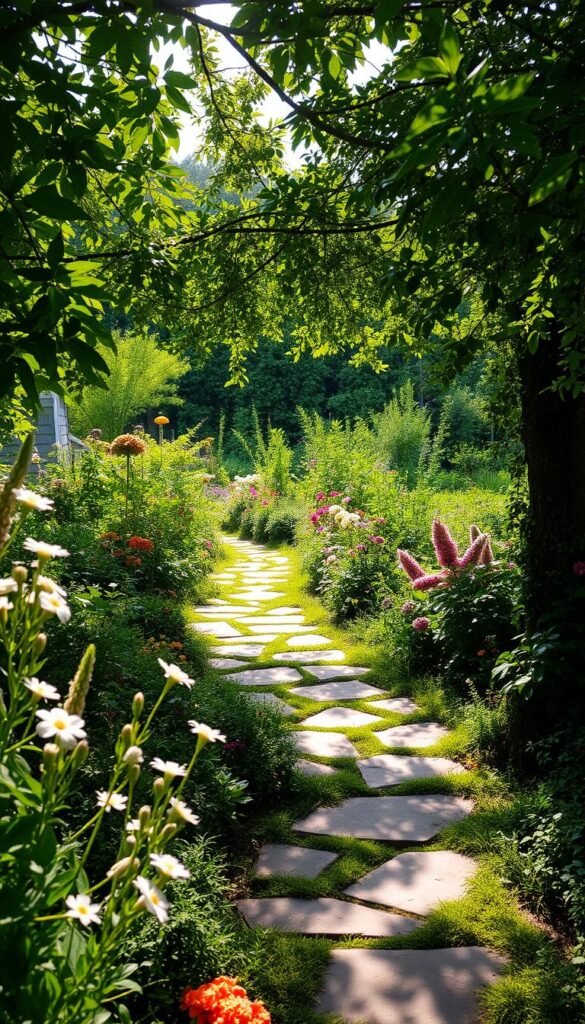
Meandering trails of weathered stone or rustic brick invite exploration through blooming borders. These paths do more than guide footsteps—they frame views and add rhythm to your garden’s story. Take inspiration from Emily Post’s historic landscape, where irregular bricks softened by time create a casually elegant route through floral displays.
Creating Stone and Brick Paths
Reclaimed materials shine in relaxed settings. Mismatched pavers laid in winding patterns suggest age and charm, while gaps filled with creeping thyme release fragrance underfoot. For durability, set stones in sand rather than mortar—this allows natural settling and encourages moss growth between cracks.
Exploring Pea Gravel and Paver Options
Crushed gravel offers budget-friendly flexibility. Its soft crunch underfoot pairs perfectly with curved designs that mimic nature’s flow. Edge gravel trails with low lavender hedges to prevent spread while adding color contrast. For structured yet organic looks, combine flat flagstones with groundcover plants like Irish moss.
When planning routes, let plantings dictate curves. A path that disappears behind roses creates anticipation, while wider sections near benches encourage lingering. Proper drainage matters: slope surfaces slightly and use permeable bases to prevent puddling after rains.
Adding Water Features and Bird Baths for Movement
The gentle murmur of water adds a soothing rhythm to your outdoor sanctuary. A stone bird bath nestled among coneflowers or a petite fountain creates focal points that blend cottage charm with ecological purpose. These elements invite life into your space—birds splashing at dawn, bees pausing to drink, and breezes carrying the sound of trickling water.
Choosing the Perfect Fountain or Bird Bath
Opt for materials like weathered stone or ceramic that age gracefully. Shallow basins (1-2 inches deep) let pollinators access water safely. Emily Henderson’s tiered fountain shows how movement and form can coexist—its gentle flow attracts hummingbirds without overwhelming compact spaces.
Attracting Birds and Pollinators
Position baths near tall plants like bee balm for shelter. Add flat stones as landing pads for butterflies. Refresh water every 2-3 days to prevent stagnation. Solar-powered fountains eliminate cords while keeping water oxygenated—a win for wildlife and low-maintenance garden care.

